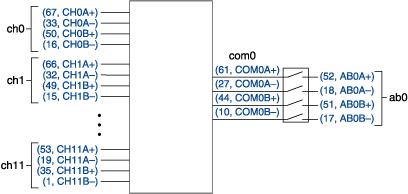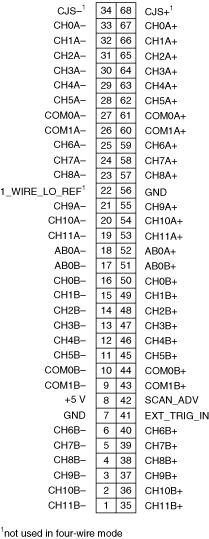NI PXI-2501/2503 4-Wire 12×1 Multiplexer Topology
When using the NI PXI-2501/2503 as a 4-wire 12×1 multiplexer, connect your signals using the NI TB-2605 terminal block. The following figure is a representation of the NI PXI-2501/2503 in this mode.
 |
 |
4-wire mode is usually used in 4-wire resistance measurements. One pair of wires supplies the excitation current while the other pair makes the voltage measurement. In 4-wire mode, connect your excitation or source leads to CHxA+ and CHxA-, and connect your measurement or sensing leads to CHxB+ and CHxB-, as shown in the following figure:
 |
 |
 |
Note The previous figure shows the DMM connected to the analog bus (AB) of the switch module. Instead of routing signals to the AB, you can connect COM0A+ and COM0A- to the excitation terminals and COM0B+ and COM0B- to the sense terminals of the DMM. |
Making a Connection
During scanning, a typical scan list entry is ch2->com0;. This entry routes the excitation signals from CH2A+ and CH2A- to COM0A+ and COM0A-, respectively. This entry also routes the sensing lead from CH2B+ and CH2B- to COM0B+ and COM0B+, respectively.
During immediate operations when using niSwitch Connect Channels with ch2 and com0, the excitation signals are routed from CH2A+ and CH2A- to COM0A+ and COM0A-, respectively. This call also routes the sensing lead from CH2B+ and CH2B- to COM0B+ and COM0B+, respectively. To route AB0A± and AB0B± to CH2A± and CH2B±, respectively, call niSwitch Connect Channels with com0 and ab0.
Pinout
The following figure identifies the pins for the NI PXI-2501/2503 in the 4-wire 12×1 multiplexer topology.
